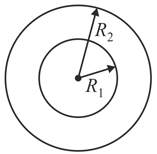A cone of radius and height is placed in an uniform electric field as shown in the figure (a), if the axis of the cone made inclined with the vertical as shown in the figure (b). Calculate the flux of electric field entering the cone.
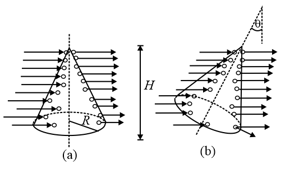


Important Questions on Electric Flux and Gauss's Law
Point charge is placed at a point on the axis of a square non-conducting surface. The axis is perpendicular to the square surface and is passing through its centre. The flux of Electric field through the square caused due to charge is . If the square is given a surface charge of uniform density , find the magnitude of the force on the square surface due to point charge .
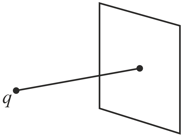
The three small spheres as shown in figure carry charges and . Find the net electric flux through each of the following closed surfaces shown in cross-section in the figure.
(a) , (b) , (c) , (d) , (e)
Do your answers to parts from (a) to (e) depend on how the charge is distributed over each small sphere? Why or why not?
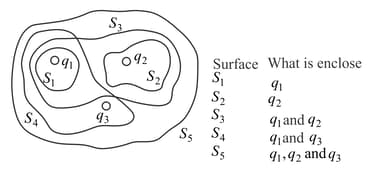
A conducting sphere carrying charge is surrounded by a spherical conducting shell.
(a) What is the net charge on the inner surface of the shell?
(b) Another charge is placed outside the shell. Now, what is the net charge on the inner surface of the shell?
(c) If is moved to a position between the shell and the sphere, what is the net charge on the inner surface of the shell?
(d) Are your answers valid if the sphere and shell are not concentric?
A solid insulating sphere of radius carries a net positive charge , uniformly distributed throughout its volume. Concentric with this sphere is a conducting spherical shell with an inner radius and outer radius and having a net charge , as shown in the figure.
(a) Consider a spherical Gaussian surface of radius , the net charge enclosed by this surface is _____.
(b) The direction of the electric field is ___ .
(c) The electric field at is _____.
(d) The electric field in the region with radius , where , is _____.
(e) Consider a spherical Gaussian surface of radius , where , the net charge enclosed by this surface is _____.
(f) Consider a spherical Gaussian surface of radius , where , the net charge enclosed by this surface is _____.
(g) The electric field in the region is _____.
(h) Consider a spherical Gaussian surface of radius . Find an expression for the net charge enclosed by this surface as a function of . Note that the charge inside this surface is less than .
(i) The electric field in the region is _____.
(j) The charge on the inner surface of the conducting shell is _____.
(k) The charge on the outer surface of the conducting shell is _____.
(l) Make a plot of the magnitude of the electric field versus .
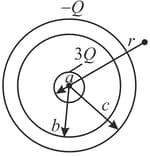
A small conducting spherical shell with an inner radius and outer radius is concentric with a larger conducting spherical shell with an inner radius and outer radius . The inner shell has a total charge and the outer shell has charge .
(a) Make a plot of the magnitude of the electric field versus .
(b) Calculate the electric field (magnitude and direction in terms of ) and the distance from the common centre of the two shell for Show your result in a graph with a radial component of as function of .
(c) What is the total charge on the
(i) inner surface of the small shell;
(ii) outer surface of the small shell;
(iii) inner surface of the large shell;
(iv) outer surface of the large shell?
Which of the following statements is/are correct?
(a) Electric field calculated by Gauss law is the field due to only those charges which are enclosed inside the Gaussian surface.
(b) Gauss law is applicable only when there is symmetrical distribution of charge.
(c) Electric flux through a closed surface is equal to total flux due to all the charges enclosed within that surface only.
Which of the following statements is correct? If , at all points of a closed surface,
(a) the electric flux through the surface is zero.
(b) the total charge enclosed by the surface is zero.
A hollow dielectric sphere, as shown in figure, has inner and outer radii of and , respectively. The total charge carried by the sphere is , this charge is uniformly distributed and
(a) Then, the electric field for is zero. (Yes/No)
(b) Then, the electric field for is given by ______.
(c) Then, the electric field for is given by _____.
